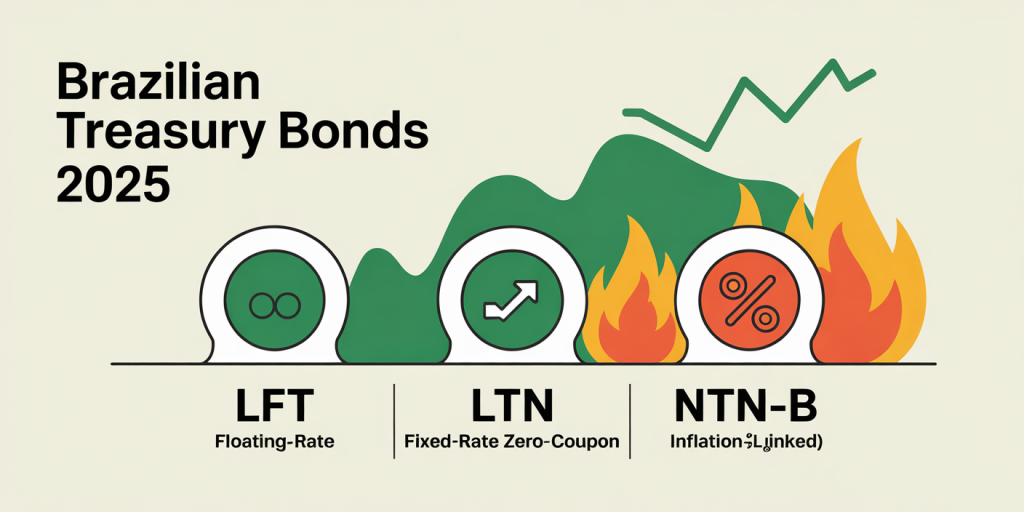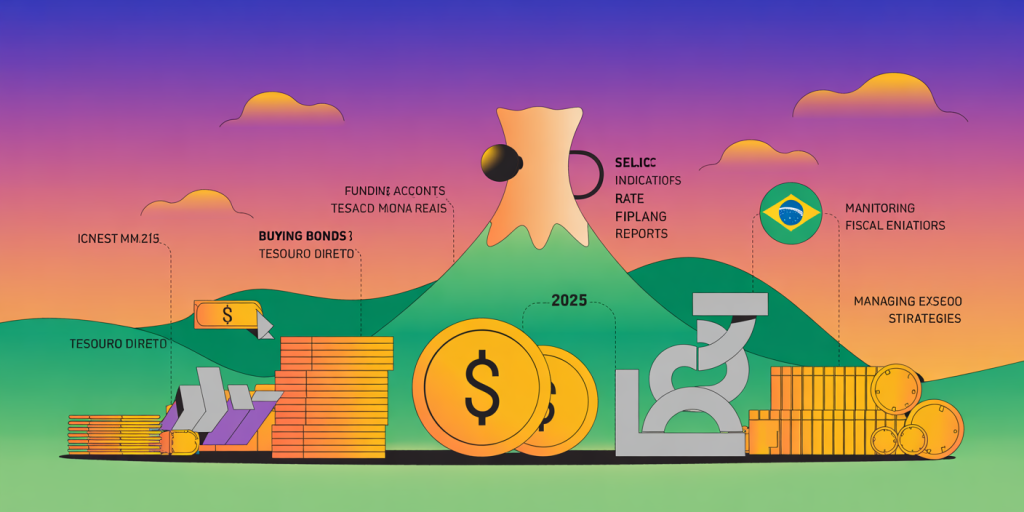How to Invest in Brazilian Treasury Bonds in 2025: Step by Step
Anúncios
Investing in Brazilian Treasury Bonds can be an excellent opportunity for those looking to diversify their portfolio with relatively low-risk assets while earning attractive returns tied to Brazil’s economic environment. In 2025, Brazil’s economic outlook coupled with changes in regulatory frameworks and improved access for international investors make treasury bonds an appealing investment option. This article will guide you step-by-step on how to invest in Brazilian Treasury Bonds in 2025, providing practical advice and up-to-date market insights.

Understanding Brazilian Treasury Bonds and Their Appeal in 2025
Anúncios
Brazilian Treasury Bonds, known locally as “Títulos Públicos Federais,” are debt securities issued by the Brazilian government to finance public spending. These bonds are among the safest investments in Brazil, backed by the full faith and credit of the government. They vary widely in terms of maturity, yield type (fixed vs. inflation-linked), and payout frequency.
In the current economic context (early 2025), Brazil’s GDP growth forecast is approximately 2.3% annually, according to the IMF. Inflation remains relatively controlled, hovering near the Central Bank’s target of 4.0%. The Selic rate (Brazil’s central bank interest rate) stands at 12.25%, indicating an environment of elevated interest rates, which directly influence the yields of treasury bonds.
For investors, these conditions translate into higher yields on fixed income assets, with inflation-linked bonds offering protection against unexpected inflation rises. Moreover, recent regulatory improvements have simplified access to these assets, especially for international investors, enhancing liquidity and market depth.
Step 1: Choose the Type of Treasury Bond Suitable for Your Investment Goals
Brazil offers several types of treasury bonds, each catering to different investor needs. The main categories are: LFT (Letras Financeiras do Tesouro): These are floating-rate bonds indexed to the Selic rate, providing daily yield adjustment based on the benchmark interest rate. Ideal for investors seeking to keep pace with monetary policy. LTN (Letras do Tesouro Nacional): Fixed-rate zero-coupon bonds, paid at maturity. These suit investors looking for guaranteed returns over a fixed time horizon. NTN-B and NTN-B Principal: Inflation-linked bonds indexed to the IPCA inflation index. They pay semi-annual coupons (NTN-B) or pay principal and interest only at maturity (NTN-B Principal).
For example, if an investor expects inflation to rise above the Central Bank’s target, buying NTN-B bonds could protect purchasing power while earning a real yield above inflation. Conversely, if an investor prefers stable income, they may opt for LTN or fixed-rate NTN from a recent auction or the secondary market.
| Bond Type | Yield Type | Maturity Range | Payment Frequency | Investment Goal |
|---|---|---|---|---|
| LFT | Floating (Selic) | 2-5 years | At maturity | Protect against interest rate changes, liquidity |
| LTN | Fixed (Zero-Coupon) | 1-10 years | At maturity | Guarantee fixed return |
| NTN-B (IPCA+) | Inflation-linked | 3-30 years | Semi-annual coupons | Hedge inflation |
| NTN-B Principal | Inflation-linked | 3-30 years | At maturity | Long-term inflation protection |
This table illustrates how different bonds meet various investor demands and time horizons.
Step 2: Open an Account with Authorized Brokers or Banks
To invest in Brazilian Treasury Bonds, investors must hold an account with authorized institutions such as brokers, banks, or the Tesouro Direto platform. In 2025, Tesouro Direto remains the most popular and accessible platform for retail investors, offering a straightforward interface and direct purchase access.

For domestic investors, opening an account with brokers like XP Investimentos, Itaú Corretora, or Clear Corretora provides access to a wide range of treasury products and research tools. Foreign investors can also participate but may face additional regulatory requirements. Non-resident investors typically must comply with Brazil’s CVM (Securities and Exchange Commission) rules, including registration with the Receita Federal (Brazilian IRS) and may require a Brazilian tax identification number (CPF).
For instance, João, a Brazilian investor in São Paulo, simply opened an account at XP Investimentos and registered on Tesouro Direto to start buying government bonds on the platform directly through his smartphone. Meanwhile, Sarah, a foreign investor from the US, opened a brokerage account with a bank offering custody services specialized in international clients and followed the local registration process to start investing.
Step 3: Fund Your Account with Brazilian Reais (BRL)
Purchasing treasury bonds typically involves transactions in the national currency, the Brazilian Real. Whether you are a domestic or foreign investor, you must deposit sufficient BRL into your brokerage or Tesouro Direto account to proceed with purchases.
For international investors, currency conversion is a critical consideration. Given the recent volatility in the BRL/USD exchange rate—where in early 2025 the Real traded between 5.00 and 5.30 per US dollar—timing currency conversion to avoid unfavorable spreads or risks can impact overall returns.
For example, an American investor converting USD 10,000 into BRL would receive roughly BRL 50,000 at a 5.00 exchange rate. If the Real depreciates further after bond purchase, the bond’s local return might diminish in USD terms. To mitigate foreign exchange risk, some foreign investors hedge their BRL exposure using FX derivatives or invest only through Global Bonds issued by Brazil.
Practical note: many Brazilian brokerages offer currency conversion services integrated into the account platform, making the entire process seamless for retail clients.
Step 4: Purchase Treasury Bonds Through Tesouro Direto or Secondary Market
With funds ready, investors can proceed to purchase bonds. Tesouro Direto, Brazil’s government online bond trading platform, offers an easy way to buy bonds at a fixed price updated daily. Investors can select bond series, quantities, and payment modalities through the platform’s user-friendly interface.
For large investors or those seeking specific maturities, the secondary market offers opportunities via B3—the Brazilian stock exchange. Bonds traded in B3 can be bought in real-time market prices, potentially offering pricing advantages or market liquidity during trading hours.
Case Study: In 2024, a mid-sized pension fund purchased NTN-B bonds through the B3 exchange to match its inflation-linked liabilities. By negotiating directly with traders, they secured bonds at a slight discount relative to Tesouro Direto prices, boosting portfolio performance.
Transaction costs vary: Tesouro Direto charges low fees (around 0.25% annually), while brokers and B3 transactions may have brokerage fees and taxes. Investors should review fee structures before choosing their purchase route.
Step 5: Monitor Your Investment and Plan Exit Strategies
After purchasing, continuous monitoring is crucial. Investors must follow macroeconomic indicators like inflation data, Central Bank meeting minutes, and public debt reports, as these signals affect bond performance.
For example, prolonged high inflation might make inflation-linked bonds attractive, whereas falling interest rates typically increase prices of fixed-rate bonds, presenting an opportunity to sell at a profit in the secondary market.
Investors should also evaluate their portfolio maturity profile. Some bonds have long maturities extending 10 to 30 years, while others mature in a few years. Knowing when to exit is vital to optimize returns or reinvest in new series.
A practical tip: Tesouro Direto offers automatic notifications about price movements and maturity dates, aiding investor management of bond holdings without complex tracking.
| Key Indicators to Monitor | Impact on Bonds | Recommended Action |
|---|---|---|
| Selic Rate Changes | Affects floating rate bonds | Consider switching bond types |
| IPCA Inflation Trends | Determines real yield on NTN-B | Rebalance between inflation-linked and nominal bonds |
| Government Fiscal Reports | Indicate credit risk situations | Adjust portfolio risk exposure |
| Currency Exchange Rates | Affect international returns | Hedge or diversify currency exposure |
Future Perspectives on Brazilian Treasury Bond Investment

The outlook for Brazilian Treasury Bonds in 2025 and beyond appears promising but nuanced. Brazil’s ongoing fiscal reforms, infrastructure investments, and growing regional trade partnerships could improve credit quality and investor confidence. The Central Bank’s inflation targeting framework and cautious monetary policy management suggest interest rates may gradually moderate from current high levels of 12.25% to more normalized levels between 8-10% over the next two years.
For investors, this means a potentially favorable environment where fixed income assets deliver steady, attractive yields coupled with inflation protection. Additionally, digital innovation within Tesouro Direto and increasing participation of foreign investors may enhance market liquidity, reducing volatility and transaction costs.
Moreover, Brazil’s commitment to green economic policies is paving the way for “green bonds,” which might become another category investors can explore within the sovereign debt spectrum.
In sum, understanding the diversity of bond types, maintaining regulatory compliance, and actively managing currency and market risks remain essential components for successful investing in Brazilian Treasury Bonds in 2025. Savvy investors who follow the steps described and remain attuned to Brazil’s dynamic macroeconomic landscape will be well-positioned to harness the opportunities these government bonds offer in the near future.
